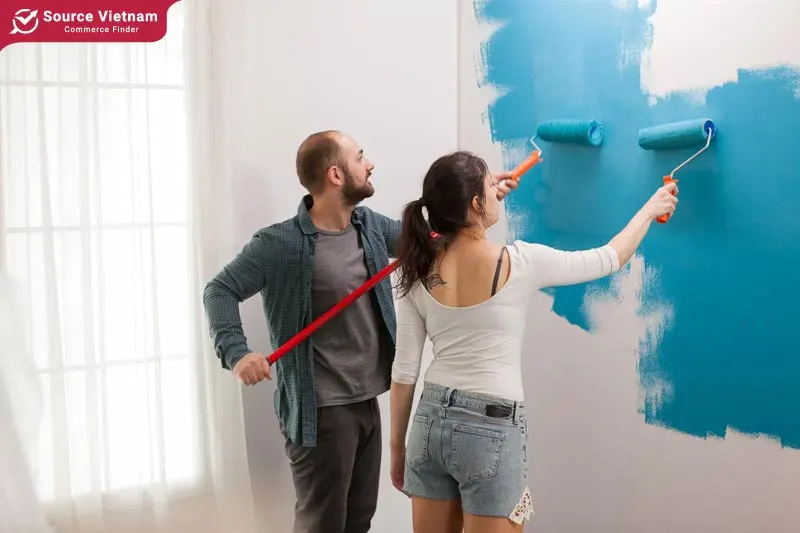The wall color will have a direct impact on your sleep quality. Some trending colors like mint green, pastel pink, and beige are becoming popular choices. Let’s check out the article to learn more about what’s a good color for a bedroom.
An overview of the psychological impact of color
The choice of colors for your bedroom and bedding can have a profound impact on your sleep. How does your bedroom color influence your sleep quality? What color helps you sleep better? Let’s explore the science behind color and sleep.

Learning more about the effects of color
Scientific studies have shown that colors exert a powerful influence on human psychology and behavior. Colors serve as emotional touchstones, evoking memories and experiences. This is why we associate specific colors with feelings; for instance, green is often linked to peace and tranquility, while red is associated with passion and energy.
Colors stimulate our senses by directly affecting our vision. This visual input is then processed by the brain, triggering various emotions and sensations. Consequently, it has been demonstrated that colors can significantly alter our moods. Bright colors tend to evoke feelings of joy and excitement, whereas darker hues can create a sense of calmness or melancholy.
Beyond influencing emotions, colors can also impact our behavior. For example, warm colors like red can stimulate appetite, while blue can enhance focus. Major brands worldwide leverage the color psychology to design their logos and packaging, aiming to influence consumer choices. Some colors that have a particularly strong impact on our behavior and emotions include:
- Red: Symbolizing energy, passion, and excitement, red is often associated with danger or urgency.
- Orange: Evoking feelings of warmth and friendliness, orange is known to stimulate appetite and creativity.
- Yellow: Associated with happiness and optimism, yellow is a cheerful color that can also be attention-grabbing.
- Green: Often linked to nature and growth, green is calming and balancing.
- Blue: Symbolizing trust and loyalty, blue is often associated with calmness and tranquility.
- Purple: Associated with royalty and luxury, purple is also linked to spirituality and creativity.
- Black: Representing power and mystery, black can also evoke feelings of sadness or elegance.
- White: Symbolizing purity and innocence, white is often associated with cleanliness and simplicity.
The bedroom colors for better sleep
For this scientific reason, choosing the overall color for a bedroom is extremely important. If your bedroom has the right colors, creating a relaxing and pleasant feeling, you will feel comfortable and fall asleep more easily. The choice of bedroom colors also depends on personal preference, but if you want the most comfortable feeling, the following popular bedroom paint colors, would be the best choice.

- Blue evokes a sense of calm: often considered the best color for sleep, blue is often reminiscent of the sky and beaches, natural elements that make us feel peaceful. In fact, a survey has shown that people who sleep in blue bedrooms tend to sleep longer and better. This color also helps to reduce heart rate and blood pressure, helping us relax optimally.
- Green brings peace: Green is the color of nature, reminiscent of lush trees or cool tropical forests. It is also associated with renewal, rest, reduced anxiety, and promotes health. When sleeping in a green room, you can wake up feeling refreshed and healthy.
- White and gray evoke a sense of cleanliness and spaciousness: These are two colors often chosen for bedding and wall colors. White or light gray will make you feel light, peaceful and create a spacious, airy feeling. These two colors are perfect for those who pursue a minimalist style.
- Beige and cream create a gentle relaxation: These are two of the most common colors in spas and beauty salons because they create a warm, inviting and gentle feeling. This is an easy color to match and pleasant, making us feel more comfortable.
- Light pink brings comfort: As a soft color, light pink will make us feel comfortable and get mood enhancement. Helping us fall asleep more easily than ever.
Colors to avoid when painting a bedroom
While there are certain colors that promote relaxation and restful sleep, it’s equally important to avoid those that can have a negative impact on your mood and energy levels. Over time, exposure to certain colors can lead to undesirable psychological effects.
- Red, a stimulating color, can elevate your heart rate and make it difficult to relax. Its vibrant energy can create an overstimulated environment, making it challenging to fall asleep.
- Black, often associated with darkness and confinement, can make a space feel smaller and more claustrophobic. While it can be used as a dramatic accent, it’s not ideal for the main walls of a bedroom.
- Bright purple can overstimulate the mind, making it difficult to unwind and drift off to sleep. Its intense hue can lead to restless nights.
- Dark brown can create a heavy, oppressive atmosphere, especially in smaller spaces. This color can contribute to feelings of gloominess and unease.
- Bright yellow and orange, known for their stimulating qualities, can excite the mind rather than calm it. These vibrant colors are not conducive to a restful sleep environment.
Some paint color trends for bedrooms
Nowadays, bedroom decor trends have changed a lot. With the continuous development of aesthetic tastes and the impact of modern trends, bedrooms have undergone many innovations. Let’s explore some of the most bedroom color ideas today.

The rise of soft neutral tones
Gentle hues such as cream and beige have gained significant popularity and are one of the best paint colors for bedrooms. Beyond bedrooms, these colors are increasingly used in relaxation spaces like spas and massage parlors. Some homeowners even opt for a monochromatic look throughout their entire home. Korean-style cafes have embraced these soothing tones.
Light gray and gray blue have also become trendy choices, calming colors for bedrooms and especially among younger generations. These colors lend a sophisticated, luxurious, and contemporary feel to any bedroom.
The appeal of bright and cheerful hues
While neutral tones continue to trend, there is a growing fondness among young people for vibrant and energetic colors. Inspired by popular culture and contemporary design trends, hues like mint green, pastel pink, and light yellow have gained popularity.
These cheerful colors, once considered less conventional, are now being embraced for their ability to create a fresh, uplifting atmosphere in bedrooms. Their sweet and playful nature can also boost mood and promote a sense of happiness.
Earthy tones and deep hues
Deep green, moss green, and terracotta are another good color for bedroom. These earthy tones evoke a sense of connection to nature, offering a warm and classic aesthetic. They are particularly appealing to those who appreciate the rich, luxurious look of traditional design.
Essential tips for selecting the perfect bedroom paint color
What is the best color for a bedroom? To create a restful and rejuvenating space, choosing the right paint color is crucial. Here are some key factors to consider what color is best for sleep in your bedroom:
- Opt for neutral tones: If you’re unsure about bold or bright hues, neutral colors are best bedroom colors and offer a harmonious and calming solution. They create a sense of spaciousness and can be adapted to various interior designs.
- Choose long-lasting paint: Investing in high-quality paint that resists fading will save you time and money in the long run. Classic neutrals like white and light gray are timeless choices.
- Personalize your space: Your bedroom should reflect your personal style. Select colors that bring you joy and create a relaxing atmosphere.
- Coordinate with existing decor: To achieve a cohesive look, choose a wall color that complements your existing furnishings and accessories. There are many different interior design styles such as contemporary , modern, and classic. You need to identify which style your home furnishings belong to to choose the right paint color.
- Consider room size and lighting: The size and natural light in your bedroom will impact how a color appears. Light colors can make small spaces feel larger.
- Seek professional advice: If you’re feeling overwhelmed by the many color options, consult with an interior designer for personalized guidance.
A step-by-step guide to painting your bedroom
Want to give your bedroom makeover? Painting is a simple and affordable way to transform your space. After choosing what’s a good color for a bedroom, let’s follow these easy steps to achieve a professional finish.

Prepare necessary tools
Before you begin painting wall colors for bedroom, make sure you have all the necessary tools. This will help ensure a smooth and efficient painting process.
- Paint: Select the appropriate paint for your wall type. It’s a good idea to purchase a bit extra to avoid running out mid-project.
- Paint rollers and brushes: Both rollers and brushes will be useful for different areas of your wall.
- Paint tray: A paint tray can be purchased or repurposed from an old container.
- Gloves: Protect your hands from paint.
- Drop cloth: Cover your floors and furniture to prevent paint splatters.
- Additional tools: You may also need painter’s tape, rags, and a ladder.
Surface preparation
Before you start painting, it’s important to prepare the wall surface.
- Clean the wall: Remove any dirt, dust, or loose particles with a damp cloth.
- Repair any damage: Fill any cracks or holes with spackling compound and let it dry completely.
- Sand the surface: Lightly sand the wall to create a smooth surface and help the paint adhere better.
- Protect other areas: Use painter’s tape to mask off areas you don’t want to paint, such as trim, windows, and outlets.
Applying the paint
- Mix the paint: Follow the manufacturer’s instructions for mixing the paint.
- Apply a primer coat: A primer coat will help the paint adhere to the wall and provide a more even finish.
- Apply the first coat: Begin painting in a corner and use a roller to apply an even coat of paint to the wall.
- Apply the second coat: Once the first coat is completely dry, apply a second coat for a richer color and a more uniform finish.
- Paint the edges: Use a brush to paint the edges, corners, and any areas that the roller can’t reach.

Painting tips and tricks
- Clean up: Once you’ve finished painting, remove any painter’s tape and clean your brushes.
- Test the color: Before you commit to a color, paint a small patch on the wall to see how it looks in your space.
- Consider the lighting: Natural and artificial light can affect how a color appears.
- Be patient: Painting takes time. Take your time and ensure a smooth, even finish.
- Ventilate the room: Open windows to allow for proper ventilation.
- Protect yourself: Wear gloves and a mask to protect your skin and lungs.
- Childproof: Keep paint and supplies out of reach of children.
Transform your bedroom with the perfect furniture
Your bedroom should be a sanctuary where you can relax and recharge. Create a space that reflects your personal style with the right furniture. Consider coordinating your bed linens and other decor with your wall color for a cohesive look.
Sourcevietnam is your one-stop shop for home furnishings. We offer a wide range of wholesale bedroom furniture directly from manufacturers at wholesale prices, helping you create a beautiful and affordable home. Explore our collection today.
Found your ideal colors with our ‘what’s a good color for a bedroom’ guide? Great! Now, elevate your bedroom with stylish furniture and decor from Sourcevietnam. Explore their wide selection and bring your vision to life.
FAQ about good color for a bedroom
What are the best colors for a small bedroom?
For small rooms, light colors such as bright white, beige, cream, and pastel yellow are ideal for creating an illusion of space.
How does color affect sleep quality?
Color psychology, the study of how colors influence human perception and behavior, has a profound impact on our emotional state and actions. As a result, calming colors promote relaxation and better sleep, whereas stimulating colors can disrupt our sleep.
Are there specific colors that make a bedroom look bigger?
Opting for colors such as pristine white, ethereal light blue, calming grey, warm beige, or creamy tones can dramatically enhance the sense of spaciousness in your bedroom. These pale and reflective shades effortlessly create an illusion of a larger sleeping area, making your bed appear more prominent and inviting.
What are some popular bedroom color trends for this year?
You might want to consider these popular color trends: sage green, forest green, earthy tones, soft blues, aqua and teal, creams and beiges, and white. They are excellent choices.















